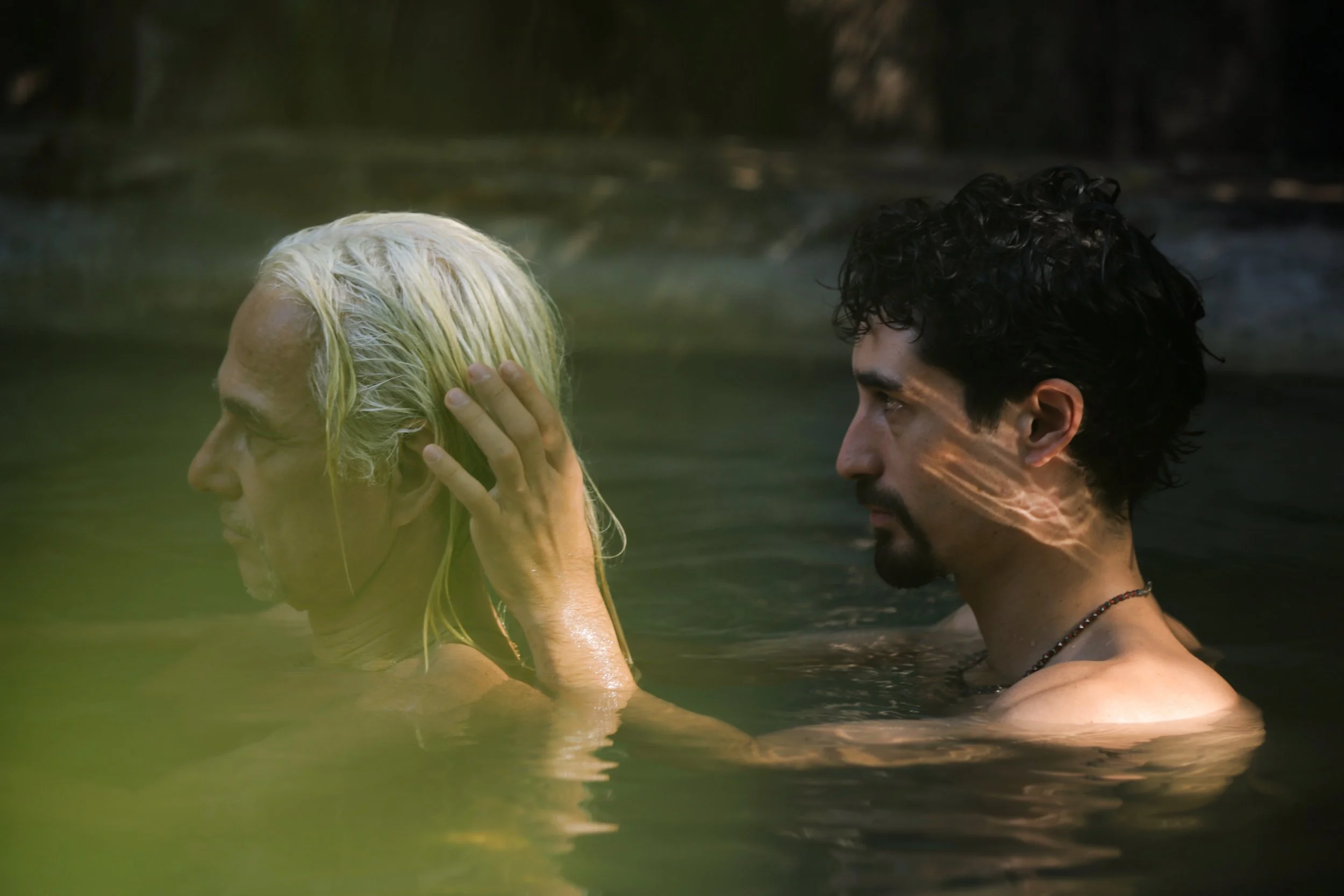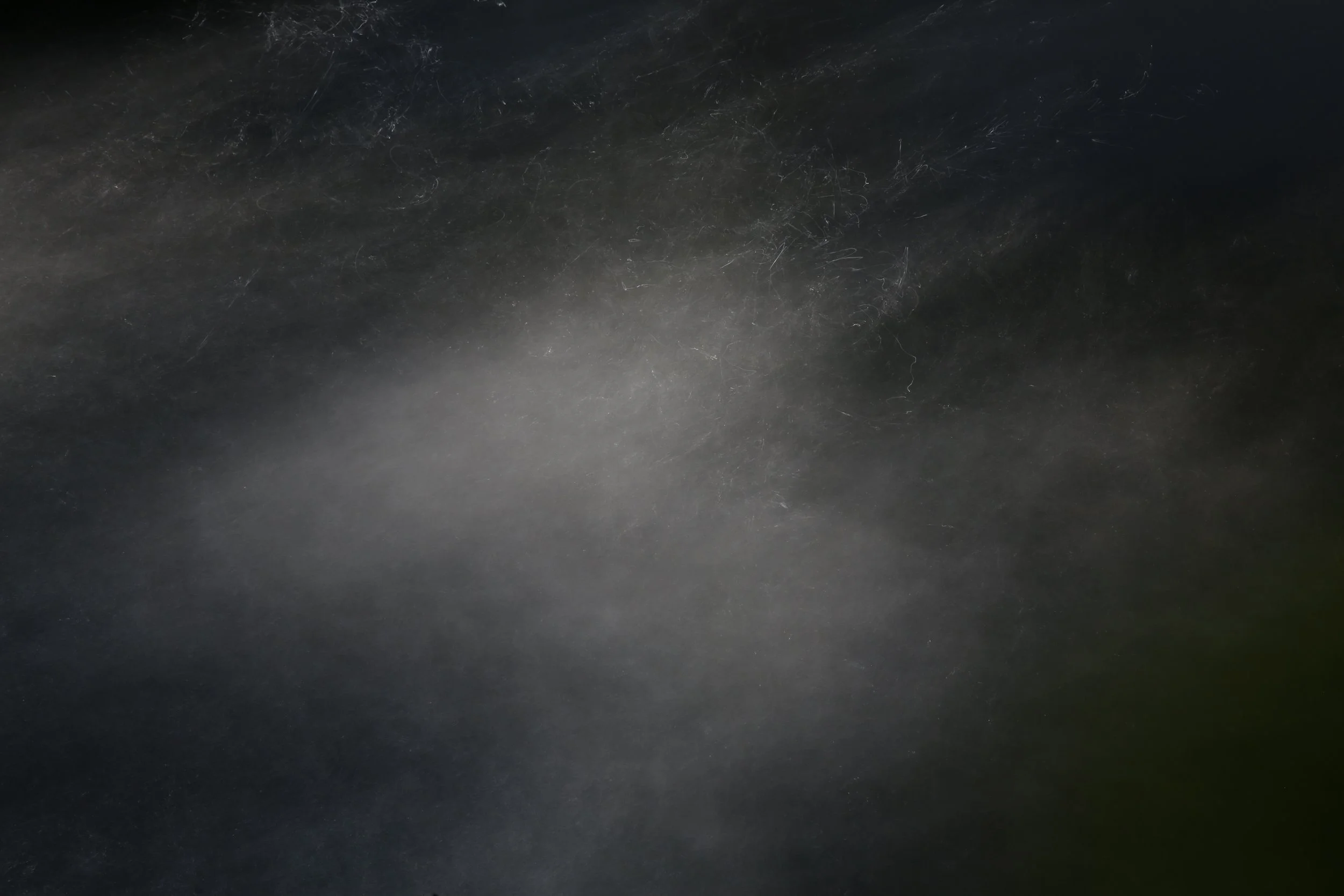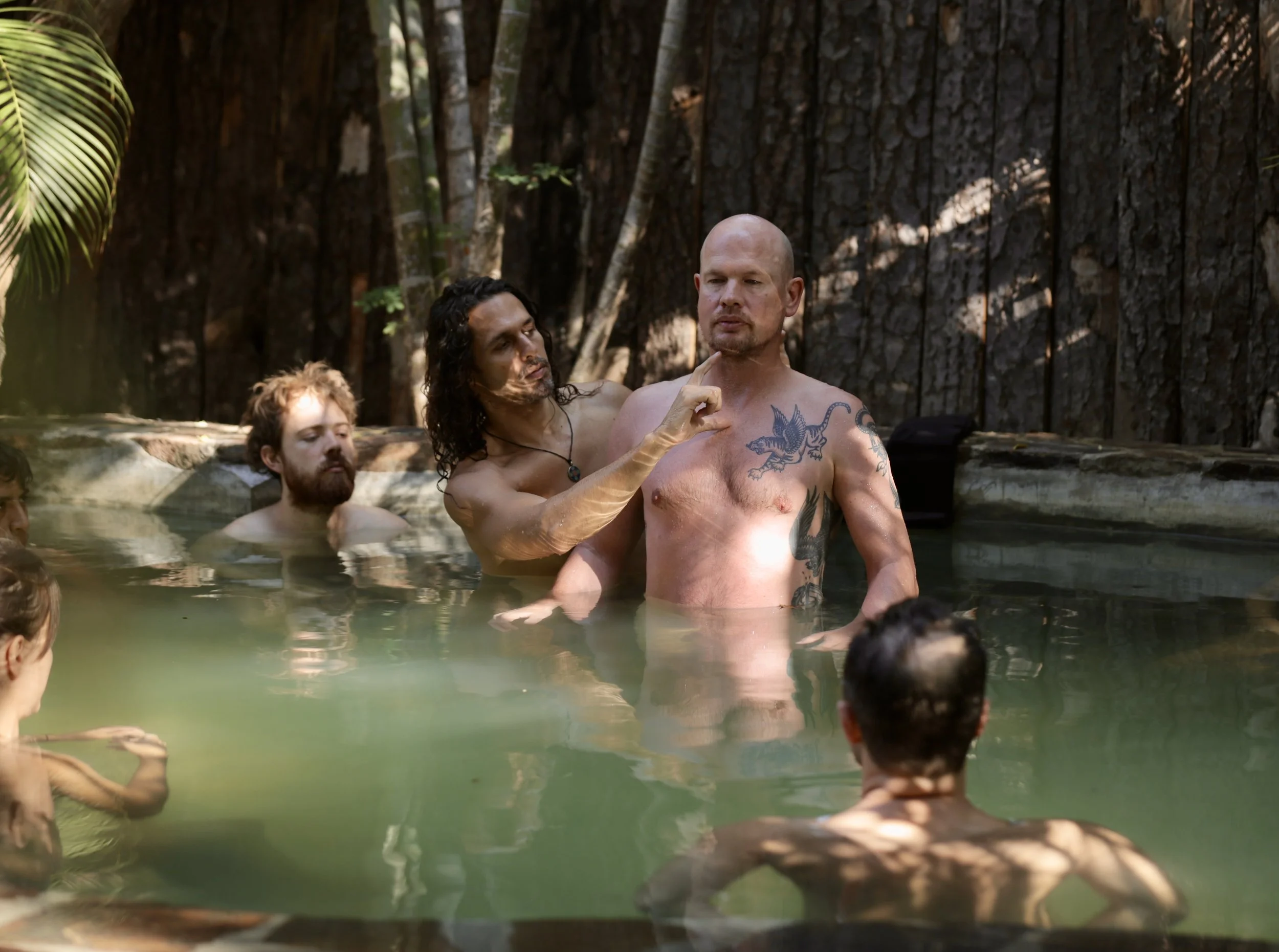
When we allow ourselves to reflect as mirrors, becoming empty vessels that resonate with all the turmoil and beauty within another, we signal a path towards wholeness. By way of presence and recognition.
Marco & Claus, Oaxaca, by Mayra Garcia
A 300-hour facilitator training
with Steve Karle
This journey follows on from our 12-day immersion, guiding you into the depths of your own primordial expression while refining your capacity for attuned listening and empathetic sensitivity — in service of facilitating the expression in others professionally, both on land and in water. Our educational approach is deeply creative and experiential, guided not by fixed structures but by the organic unfolding of the process itself — personal, collective, and ever-evolving.
Yasumi, Takako & Kenji, Amanemu, Japan
Our take on education
There are many so called holistic practices that rely on methods, protocols, sequences, or techniques. To a greater or lesser degree, they tell us how to think or do things. We start from the premise that we already know. Because when it comes to the art of healing and connection, we believe there is nothing we need to learn as such. It’s rather about reclaiming something innate in all of us, shedding the layers of conditioning acquired, disrupting habitual patterns, and setting aside our ideas of who we are. In this way, what we offer you on this journey, fundamentally, is a platform for you to return to your very human potential — so you may, in turn, accompany others in remembering theirs.
-
It's quite easy to complicate a simple concept, and we see this often within education, especially in the world of healing and spirituality. Too often, we find methodical, hierarchical, and dependent dynamics at play, sometimes driven by profit and control rather than a genuine desire to heal and empower. They seem to convey that happiness, therapeutic skill, or whatever it is that we seek in such journeys, is something that needs to be granted by an external entity, whether it’s a structured form or a guru. Consider modern yoga. Rather than blindly following a form, why not wonder about the impulse that first gave rise to that very form? Countless courses and certifications offer apparent answers and solutions without inviting us to participate in the question itself. While some may argue that mastering a model first is necessary to develop one's approach, we've found that this leaves people repeating that model, taking a long time, if at all, to break through.
In a world where the educational system selects and grades us based on a narrow productivity criteria, creativity and potential often take a backseat. In the alternative field however, we have an opportunity to counter that trend. In fact, we’ve found that developing one’s own art within our craft can be an incredibly simple and fluid task. To this end, freedom, creativity, and intuition, as well as embracing diversity and the full spectrum of human rhythms and abilities is paramount. This allows growth, not on a linear or individualistic path, but encompassing a sense of community and empathy, which after all, is essential in our work.

“Water is fluid, soft, and yielding. But water will wear away rock, which is rigid and cannot yield. As a rule, whatever is fluid, soft, and yielding will overcome whatever is rigid and hard. This is a paradox: what is soft is strong.”
Structure
The training is for those who have participated in our 12-day immersion. It consists of one more residential immersion: our 12-day submersion, plus some group video calls, personal practice, case study writing, as well as receiving a number of sessions. It is designed for a group of 12 participants.
-
90 hours of residential immersion + 10 hours of group video calls.
This part is open to most people, (dependant on application acceptance) whether or not you want to continue towards certification. -
After our immersion but before joining our submersion, you will be required to complete the following:
Receive 10x professional sessions of Primordial Expression. Half of these can be online.
Complete 25x 60min practice sessions (counts 25 hours towards certification)
-
90 hours of residential immersion + 10 hours of group video calls.
If you have been accepted for our 12-day Immersion, you will most likely be welcome to join the training. -
Following our Submersion, you will be required to complete the following:
25× 90min practice sessions
(40 hours towards certification)Write 10x case studies
(15 hours towards certification)
After completing your home practice, you will receive your certification.
Workshop at CAMP, Oaxaca, by Mayra Garcia

“We have to move from what is essentially an industrial model of education, which is based on linearity and conformity and batching people, to a model that is based more on principles of agriculture. Human flourishing is not a mechanical process – it’s an organic process. And you cannot predict the outcome of human development. All you can do, like a farmer, is create the conditions under which they will begin to flourish.”
Above Sophia & Nikos / Below Evagelia & Sophia Amanzoe, Greece
12-day submersion
While our 12-day immersion is an initiation in the element of water — an opening of possibilities, a dive into one’s creativity, and a solid foundation for sharing this work with others — our 12-day submersion is both a deeper descent and a space to polish your therapeutic approach towards sharing this work professionally. The journey will unfold through our own organic processes — as individuals and as a collective. More than anything, it is a lab: each day will begin in emptiness: a space of unknowing, where we attune to the wisdom of our bodies and the intelligence of the group. From here, we follow what naturally unfolds, allowing the path to reveal itself to learn what has to be learnt.
-
We don’t separate your learning path from your personal therapeutic process; the two paths go hand in hand in our work. Because a significant part of developing awareness towards facilitating the expression in others comes from your own therapeutic experience. By breaking through certain personal blocks for example, you will begin opening similar doors for others. Our training is structured around your process and the process of the group, which will inform whatever is explored and learned. Like in our 12-day immersion, our workshops will primarily be based on partner exercises and session exchanges, through which we will gradually evolve our work and quality of connection.
-
We will share our individual experiences within the group on a daily basis, not only to integrate and establish a cognitive connection with our bodily experiences but also to compare, share our observations, and learn from our mutual processes. This will allow us to gradually build a map of expressions, which will help us have a broad picture of our work, understand our body-mind connection in relation to movement, and develop a flexible system that will serve us as facilitators. We will outline this system together and it will be in continuous development and always at the service of the phenomenology of the body.

“A sphere is a totality, a whole, and water will always attempt to form an organic whole by joining what is divided and uniting it in circulation. It is not possible to speak of the beginning or end of a circulatory system, everything is inwardly connected and reciprocally related. Water is essentially the element of circulatory systems.”
Learning outcomes
By the end of this training, you will be certified to offer one'-to-one sessions of Primordial Expression (60 to 90 minutes) both in water and on land. You will have developed your very own approach within the principles of our work. While our training doesn’t follow learning outcomes as such, but rather follows the natural unfolding of processes and the learning elements that emerge from those processes, things that you will be proficient in by the end of it include:
-
You will develop somatic, emotional, psychological, and energetic listening capacities to attune deeply to yourself and others, entering a state of shared presence and deep rapport.
You will embody the principle of resonance: using your own felt experience to gain insight into the inner state of your client, seeing your own body as a mirror.
You will develop empathy through your own therapeutic journey of our work.
You will practice working with stillness and slowness — accessing depth, clarity, and subtlety — a powerful way to attune to micro-movements and impulses.
Touch is not used on the body but with it. It becomes a dynamic conversation — one that can support structure, release holding, re-pattern contact, or simply bear witness. This touch is deeply non-doing, a meditation in touch.
-
You will develop technical precision in how you support the body in water, how to work with the spine, how to engage your own body as a stable reference point in order to offer safety and trust.
Movement in water follows different laws. You will explore the mechanics of movement in a suspended medium — how to guide without effort, spiral without resistance, and initiate motion from your own center, allowing fluid forces to co-create the session.
In water, the head becomes an anchor — or a key to surrender. You’ll become familiar with subtle head holds, learning to sustain a sense of safety in the vestibular system, to stabilize the neck without gripping, and to align the craniosacral rhythm with the flow of the session.
You will encounter a range of manual techniques adapted to water — from deep, structural releases to feather-light contact. But rather than applying a sequence, you’ll learn to choose what serves the moment. These tools are not fixed methods, but responses to what the body is asking for.
-
You will explore the tremor phenomena in the body. Whether subtle or strong, tremors often signal the reintegration of stored stress, the completion of survival responses, or the emergence of deep vitality. You’ll learn to welcome tremors without pathologizing, to track their waves, and to offer a safe space where the nervous system can express what it needs, in its own time.
Spontaneous shaking can be an entry point to transformation. It may precede a shift, signal a threshold, or reveal trauma moving toward resolution. You’ll learn to differentiate between disorganized and integrative shaking, to track nervous system regulation in real time, and to support these states without interfering.
-
Recognise somatic markers of trauma and develop the tools to hold, accompany, and regulate them, creating safety, promoting integration, and supporting emotional release with care and presence.
Explore the Polyvagal Theory and its practical implications in our somatic movement work in water and on land.
Learn how to identify nervous system states (fight, flight, freeze, fawn) and how to work with them.
-
Learn to build a field of trust where therapeutic connection can unfold naturally. You’ll explore boundaries, energetic exchange, emotional mirroring, and the often unspoken dance of human connection.
Recognize and work with transference, countertransference, and other unconscious dynamics that emerge in one-to-one sessions. You’ll learn to navigate them with awareness, neutrality, and care.
Trauma originates not in the event itself, but in what was missing: a witness, a safe other, a moment of repair. Through attuned presence and neutral touch, early relational ruptures can begin to reorganize, without needing to be re-lived.
True intimacy does not require exposure, effort, or even words. It can arise from the simple act of being-with — in silence, in slowness, in mutual regard. You will learn to offer a field where this can safely unfold.
-
Flow is a state of attunement. In movement and in water, you’ll deepen your ability to access a state of flow — in your body, in the body of the other, and in the relational field between you. Flow is what arises when control relaxes, when the system is safe enough to reorganize itself from within. It is really coherence.
-
Gain confidence in introducing verbal cues, reflections, and dialogue within sessions.
Learn to integrate basic psychotherapeutic skills (mirroring, reframing, holding projections) to enhance safety and clarity without leading or controlling.
-
Explore how early imprints (womb, birth, attachment) shape our patterns of relationship and regulation. Learn how these dynamics show up in sessions, and how to meet them gently through body-based presence and holding.
-
The body doesn’t move in straight lines. From cellular motion to spinal undulations, spirals are the body’s natural geometry — both in land-based movement and in water. You’ll explore how to recognize, support, and follow spiral movement patterns as they emerge spontaneously or through facilitation. Spirals help distribute force, reorganize tension, and return the system to its original intelligence.
-
Develop the capacity to support others during and after powerful experiences.
Learn to pace, ground, and accompany integration processes — including emotional closure and nervous system recalibration.
Learn somatic techniques to stimulate and tone the vagus nerve, supporting emotional resilience, calm, and connection.
Above: Sophia, Greece / Below: workshop in Portugal

“At the still point of the turning world, neither flesh nor fleshless, neither from nor towards; at the still point, there the dance is. But neither arrest nor movement. And do not call it fixity, where past and future are gathered, neither movement from nor towards, neither ascent nor decline, except for the point, the still point, there would be no dance, and there is only the dance.”





